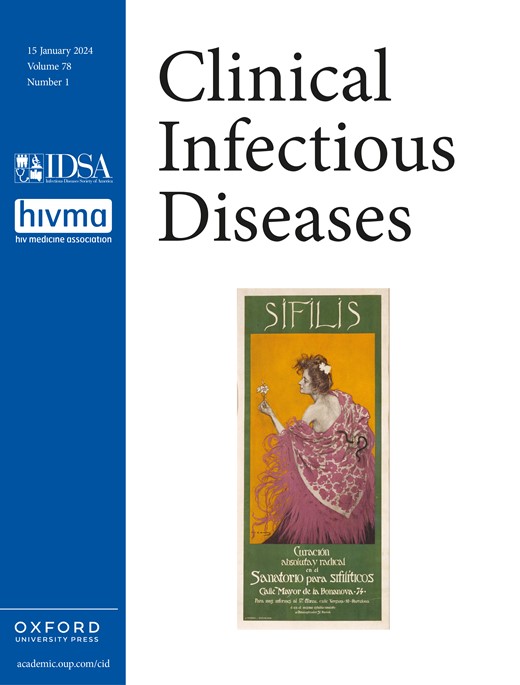卡波西肉瘤相关疱疹病毒的风险和疾病在肾供者和移植受者与HIV在美国
IF 8.2
1区 医学
Q1 IMMUNOLOGY
引用次数: 0
摘要
背景:由于卡波西肉瘤(KS)相关疱疹病毒(KSHV)在HIV感染者中的高患病率,从HIV供体(HIV D+)移植到HIV受体(HIV R+)后,KSHV相关疾病(KAD)可能会增加。方法在3个多中心肾移植研究中,采用30抗原多重测定法测定HIV R+和携带和不携带HIV (HIV D-)的供者的抗kshv抗体。KSHV血清阳性定义为对常规KSHV抗原(≥1 ORF73或K8.1)有反应;对扩大的5抗原和30抗原板的反应性也有报道。使用修正泊松回归确定危险因素。监测受者移植后抗kshv抗体变化和KAD。结果HIV R+组KSHV阳性率为40.6% (143/352),HIV D+组为25.2% (33/131),HIV D-组为7.5%(4/53)。在多变量模型中,只有男男性行为者(MSM)与KSHV血清阳性相关:受体的相对危险度为1.51(95%可信区间[CI] 1.07-2.14),供体的相对危险度为2.39(95%可信区间[CI] 1.03-5.53)。418例HIV R+(215例HIV D+/R+, 203例HIV D-/R+)中,KAD有5例(发病率0.63例/100人年,95%CI 0.26-1.52):单纯皮肤KS 3例,多中心Castleman病1例,异体移植KS 1例。异体移植物KS发生在女性HIV D+/R+中,可能来自供体。其余KAD病例发生在男性HIV D-/R+中,可能是受体KSHV再激活或获得。结论:在美国,艾滋病毒献血者和接受者的KSHV血清阳性率很高,尤其是在男男性接触者中。令人放心的是,KSHV相关疾病很少见,主要归因于受体而不是供体来源的KSHV。本文章由计算机程序翻译,如有差异,请以英文原文为准。
Kaposi Sarcoma-Associated Herpesvirus Risk and Disease in Kidney Donors and Transplant Recipients with HIV in the United States
Background Due to high prevalence of Kaposi Sarcoma (KS)-Associated Herpesvirus (KSHV) among people with HIV, KSHV-associated disease (KAD) may be increased after kidney transplantation from donors with HIV (HIV D+) to recipients with HIV (HIV R+). Methods Anti-KSHV antibodies were measured in HIV R+ and donors with and without HIV (HIV D-) using a 30-antigen multiplex assay within three multicenter kidney transplantation studies. KSHV seropositivity was defined as reactivity to conventional KSHV antigens (≥1 ORF73 or K8.1); reactivity to expanded 5-antigen and 30-antigen panels were also reported. Risk factors were identified using modified Poisson regression. Recipients were monitored for post-transplant anti-KSHV antibody changes and KAD. Results KSHV seroprevalence was 40.6% (143/352) among HIV R+, 25.2% (33/131) among HIV D+, and 7.5% (4/53) among HIV D-. In the multivariable model, only men who have sex with men (MSM) was associated with KSHV seropositivity: relative risk 1.51 (95% confidence interval [CI] 1.07-2.14) in recipients and 2.39 (95%CI 1.03-5.53) in donors. Among 418 HIV R+ (215 HIV D+/R+, 203 HIV D-/R+), there were 5 KAD cases (incidence 0.63 cases/100 person-years, 95%CI 0.26-1.52): 3 skin-only KS, 1 multicentric Castleman disease, 1 allograft KS. The allograft KS occurred in a female HIV D+/R+ and was likely donor-derived. Remaining KAD cases occurred in male HIV D-/R+ and were likely recipient KSHV reactivation or acquisition. Conclusions In the United States, KSHV seroprevalence in donors and recipients with HIV was high, particularly among MSM. Reassuringly, KSHV-associated disease was rare, and primarily attributed to recipient rather than donor-derived KSHV.
求助全文
通过发布文献求助,成功后即可免费获取论文全文。
去求助
来源期刊

Clinical Infectious Diseases
医学-传染病学
CiteScore
25.00
自引率
2.50%
发文量
900
审稿时长
3 months
期刊介绍:
Clinical Infectious Diseases (CID) is dedicated to publishing original research, reviews, guidelines, and perspectives with the potential to reshape clinical practice, providing clinicians with valuable insights for patient care. CID comprehensively addresses the clinical presentation, diagnosis, treatment, and prevention of a wide spectrum of infectious diseases. The journal places a high priority on the assessment of current and innovative treatments, microbiology, immunology, and policies, ensuring relevance to patient care in its commitment to advancing the field of infectious diseases.
 求助内容:
求助内容: 应助结果提醒方式:
应助结果提醒方式:


